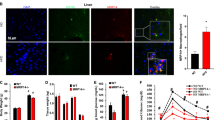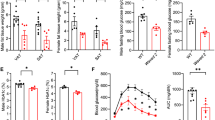Abstract
Objective:
Obesity is associated with a chronic low-grade inflammation and an increased abundance of macrophages in adipose tissue. Adipose tissue macrophages (ATMs) are assumed to interfere with adipocyte function leading to insulin resistance, thereby contributing to the pathogenesis of type 2 diabetes mellitus. Macrophages exist in separate types of differentiation, but the nature of ATMs is largely unknown.
Design and measurements:
Stromal vascular cells (SVCs) and ATMs were isolated from human adipose tissues from different locations. We characterized ATMs phenotypically and functionally by flow cytometry, endocytosis assay and determination of secreted cytokines. For comparison, we used macrophages of the ‘classical’ (M1) and the ‘alternative’, anti-inflammatory (M2) type differentiated in vitro from peripheral blood monocytes.
Results:
Like prototypic M2 macrophages, ATMs expressed considerable amounts of mannose receptor, haemoglobin scavenger receptor CD163 and integrin αvβ5. The number of cells expressing these molecules correlated significantly with the donors’ body mass indices (BMIs). Notably, SVCs positive for the common monocyte/macrophage marker CD14 contained a considerable fraction of blood monocytes, the abundance of which did not correlate with the BMIs, pointing to the requirement of the surface markers identified here for the identification of ATMs. ATMs showed endocytic activities similar to M2 macrophages and accordingly secreted high amounts of IL-10 and IL-1 receptor antagonist. However, basal and induced secretion of pro-inflammatory mediators TNF-α, IL-6, IL-1, MCP-1 and MIP-1α was even higher in ATMs than in pro-inflammatory M1 macrophages.
Conclusion:
ATMs comprise a particular macrophage type that is M2-like by surface marker expression, but they are competent to produce extensive amounts of inflammatory cytokines, which could considerably contribute to the development of insulin resistance.
This is a preview of subscription content, access via your institution
Access options
Subscribe to this journal
Receive 12 print issues and online access
$259.00 per year
only $21.58 per issue
Buy this article
- Purchase on Springer Link
- Instant access to full article PDF
Prices may be subject to local taxes which are calculated during checkout





Similar content being viewed by others
References
Dandona P, Aljada A, Bandyopadhyay A . Inflammation: the link between insulin resistance, obesity and diabetes. Trends Immunol 2004; 25: 4–7.
Weisberg SP, McCann D, Desai M, Rosenbaum M, Leibel RL, Ferrante Jr AW . Obesity is associated with macrophage accumulation in adipose tissue. J Clin Invest 2003; 112: 1796–1808.
Xu H, Barnes GT, Yang Q, Tan G, Yang D, Chou CJ et al. Chronic inflammation in fat plays a crucial role in the development of obesity-related insulin resistance. J Clin Invest 2003; 112: 1821–1830.
Bastard JP, Maachi M, Lagathu C, Kim MJ, Caron M, Vidal H et al. Recent advances in the relationship between obesity, inflammation, and insulin resistance. Eur Cytokine Netw 2006; 17: 4–12.
Permana PA, Menge C, Reaven PD . Macrophage-secreted factors induce adipocyte inflammation and insulin resistance. Biochem Biophys Res Commun 2006; 341: 507–514.
Gustafson B, Smith U . Cytokines promote WNT signaling and inflammation and impair the normal differentiation and lipid accumulation in 3T3-L1 preadipocytes. J Biol Chem 2006; 281: 9507–9516.
Jager J, Gremeaux T, Cormont M, Le Marchand-Brustel Y, Tanti JF . Interleukin-1{beta}-induced insulin resistance in adipocytes through down-regulation of IRS-1 expression. Endocrinology 2006.
Shoelson SE, Lee J, Goldfine AB . Inflammation and insulin resistance. J Clin Invest 2006; 116: 1793–1801.
Kahn BB, Flier JS . Obesity and insulin resistance. J Clin Invest 2000; 106: 473–481.
Wellen KE, Hotamisligil GS . Obesity-induced inflammatory changes in adipose tissue. J Clin Invest 2003; 112: 1785–1788.
Gordon S . Alternative activation of macrophages. Nat Rev Immunol 2003; 3: 23–35.
Mantovani A, Sozzani S, Locati M, Allavena P, Sica A . Macrophage polarization: tumor-associated macrophages as a paradigm for polarized M2 mononuclear phagocytes. Trends Immunol 2002; 23: 549–555.
Herbert DR, Holscher C, Mohrs M, Arendse B, Schwegmann A, Radwanska M et al. Alternative macrophage activation is essential for survival during schistosomiasis and downmodulates T helper 1 responses and immunopathology. Immunity 2004; 20: 623–635.
Noel W, Raes G, Hassanzadeh Ghassabeh G, De Baetselier P, Beschin A . Alternatively activated macrophages during parasite infections. Trends Parasitol 2004; 20: 126–133.
Takahashi H, Tsuda Y, Takeuchi D, Kobayashi M, Herndon DN, Suzuki F . Influence of systemic inflammatory response syndrome on host resistance against bacterial infections. Crit Care Med 2004; 32: 1879–1885.
Goerdt S, Orfanos CE . Other functions, other genes: alternative activation of antigen-presenting cells. Immunity 1999; 10: 137–142.
McGreal EP, Miller JL, Gordon S . Ligand recognition by antigen-presenting cell C-type lectin receptors. Curr Opin Immunol 2005; 17: 18–24.
Montaner LJ, da Silva RP, Sun J, Sutterwala S, Hollinshead M, Vaux D et al. Type 1 and type 2 cytokine regulation of macrophage endocytosis: differential activation by IL-4/IL-13 as opposed to IFN-gamma or IL-10. J Immunol 1999; 162: 4606–4613.
Gratchev A, Guillot P, Hakiy N, Politz O, Orfanos CE, Schledzewski K et al. Alternatively activated macrophages differentially express fibronectin and its splice variants and the extracellular matrix protein betaIG-H3. Scand J Immunol 2001; 53: 386–392.
Gratchev A, Kzhyshkowska J, Utikal J, Goerdt S . Interleukin-4 and dexamethasone counterregulate extracellular matrix remodelling and phagocytosis in type-2 macrophages. Scand J Immunol 2005; 61: 10–17.
Cinti S, Mitchell G, Barbatelli G, Murano I, Ceresi E, Faloia E et al. Adipocyte death defines macrophage localization and function in adipose tissue of obese mice and humans. J Lipid Res 2005; 46: 2347–2355.
Granelli-Piperno A, Pritsker A, Pack M, Shimeliovich I, Arrighi JF, Park CG et al. Dendritic cell-specific intercellular adhesion molecule 3-grabbing nonintegrin/CD209 is abundant on macrophages in the normal human lymph node and is not required for dendritic cell stimulation of the mixed leukocyte reaction. J Immunol 2005; 175: 4265–4273.
Robinson MJ, Sancho D, Slack EC, Leibundgut-Landmann S, Sousa CR . Myeloid C-type lectins in innate immunity. Nat Immunol 2006; 7: 1258–1265.
Jenmalm MC, Cherwinski H, Bowman EP, Phillips JH, Sedgwick JD . Regulation of myeloid cell function through the CD200 receptor. J Immunol 2006; 176: 191–199.
Watts C . Capture and processing of exogenous antigens for presentation on MHC molecules. Annu Rev Immunol 1997; 15: 821–850.
Curat CA, Miranville A, Sengenes C, Diehl M, Tonus C, Busse R et al. From blood monocytes to adipose tissue-resident macrophages: induction of diapedesis by human mature adipocytes. Diabetes 2004; 53: 1285–1292.
Curat CA, Wegner V, Sengenes C, Miranville A, Tonus C, Busse R et al. Macrophages in human visceral adipose tissue: increased accumulation in obesity and a source of resistin and visfatin. Diabetologia 2006; 49: 744–747.
de Luca C, Olefsky JM . Stressed out about obesity and insulin resistance. Nat Med 2006; 12: 41–42 discussion 42.
Lang R, Patel D, Morris JJ, Rutschman RL, Murray PJ . Shaping gene expression in activated and resting primary macrophages by IL-10. J Immunol 2002; 169: 2253–2263.
Stout RD, Jiang C, Matta B, Tietzel I, Watkins SK, Suttles J . Macrophages sequentially change their functional phenotype in response to changes in microenvironmental influences. J Immunol 2005; 175: 342–349.
Fain JN . Release of interleukins and other inflammatory cytokines by human adipose tissue is enhanced in obesity and primarily due to the nonfat cells. Vitam Horm 2006; 74: 443–477.
Lumeng CN, Bodzin JL, Saltiel AR . Obesity induces a phenotypic switch in adipose tissue macrophage polarization. J Clin Invest 2007; 117: 175–184.
Lumeng CN, Deyoung SM, Bodzin JL, Saltiel AR . Increased inflammatory properties of adipose tissue macrophages recruited during diet-induced obesity. Diabetes 2007; 56: 16–23.
Todoric J, Löffler M, Huber J, Bilban M, Reimers M, Kadl A et al. Adipose tissue inflammation induced by high-fat diet in obese diabetic mice is prevented by n-3 polyunsaturated fatty acids. Diabetologia 2006; 49: 2109–2119.
Febbraio M, Hajjar DP, Silverstein RL . CD36: a class B scavenger receptor involved in angiogenesis, atherosclerosis, inflammation, and lipid metabolism. J Clin Invest 2001; 108: 785–791.
Moestrup SK, Moller HJ . CD163: a regulated hemoglobin scavenger receptor with a role in the anti-inflammatory response. Ann Med 2004; 36: 347–354.
Zwadlo G, Voegeli R, Osthoff KS, Sorg C . A monoclonal antibody to a novel differentiation antigen on human macrophages associated with the down-regulatory phase of the inflammatory process. Exp Cell Biol 1987; 55: 295–304.
Dayer JM, Chicheportiche R, Juge-Aubry C, Meier C . Adipose tissue has anti-inflammatory properties: focus on IL-1 receptor antagonist (IL-1Ra). Ann N Y Acad Sci 2006; 1069: 444–453.
Biswas SK, Gangi L, Paul S, Schioppa T, Saccani A, Sironi M et al. A distinct and unique transcriptional program expressed by tumor-associated macrophages (defective NF-kappaB and enhanced IRF-3/STAT1 activation). Blood 2006; 107: 2112–2122.
Somm E, Cettour-Rose P, Asensio C, Charollais A, Klein M, Theander-Carrillo C et al. Interleukin-1 receptor antagonist is upregulated during diet-induced obesity and regulates insulin sensitivity in rodents. Diabetologia 2006; 49: 387–393.
Clement K, Viguerie N, Poitou C, Carette C, Pelloux V, Curat CA et al. Weight loss regulates inflammation-related genes in white adipose tissue of obese subjects. Faseb J 2004; 18: 1657–1669.
Acknowledgements
We thank Margarethe Merio and Bianca Weissenhorn for their excellent technical assistance. This work was supported by the Austrian Science Fund (P18776-B11 to TMS).
Author information
Authors and Affiliations
Corresponding author
Additional information
Supplementary Information accompanies the paper on International Journal of Obesity website (http://www.nature.com/ijo)
Rights and permissions
About this article
Cite this article
Zeyda, M., Farmer, D., Todoric, J. et al. Human adipose tissue macrophages are of an anti-inflammatory phenotype but capable of excessive pro-inflammatory mediator production. Int J Obes 31, 1420–1428 (2007). https://doi.org/10.1038/sj.ijo.0803632
Received:
Revised:
Accepted:
Published:
Issue Date:
DOI: https://doi.org/10.1038/sj.ijo.0803632
Keywords
This article is cited by
-
Obesity-induced and weight-loss-induced physiological factors affecting weight regain
Nature Reviews Endocrinology (2023)
-
Near-roadway air pollution, immune cells and adipokines among obese young adults
Environmental Health (2022)
-
Adaptive immune cells shape obesity-associated type 2 diabetes mellitus and less prominent comorbidities
Nature Reviews Endocrinology (2022)
-
Possible mediators of metabolic endotoxemia in women with obesity and women with obesity-diabetes in The Gambia
International Journal of Obesity (2022)
-
HbA1c levels and circulating inflammatory proteins at onset of type 1 diabetes in children and adolescents
Journal of Diabetes & Metabolic Disorders (2022)



